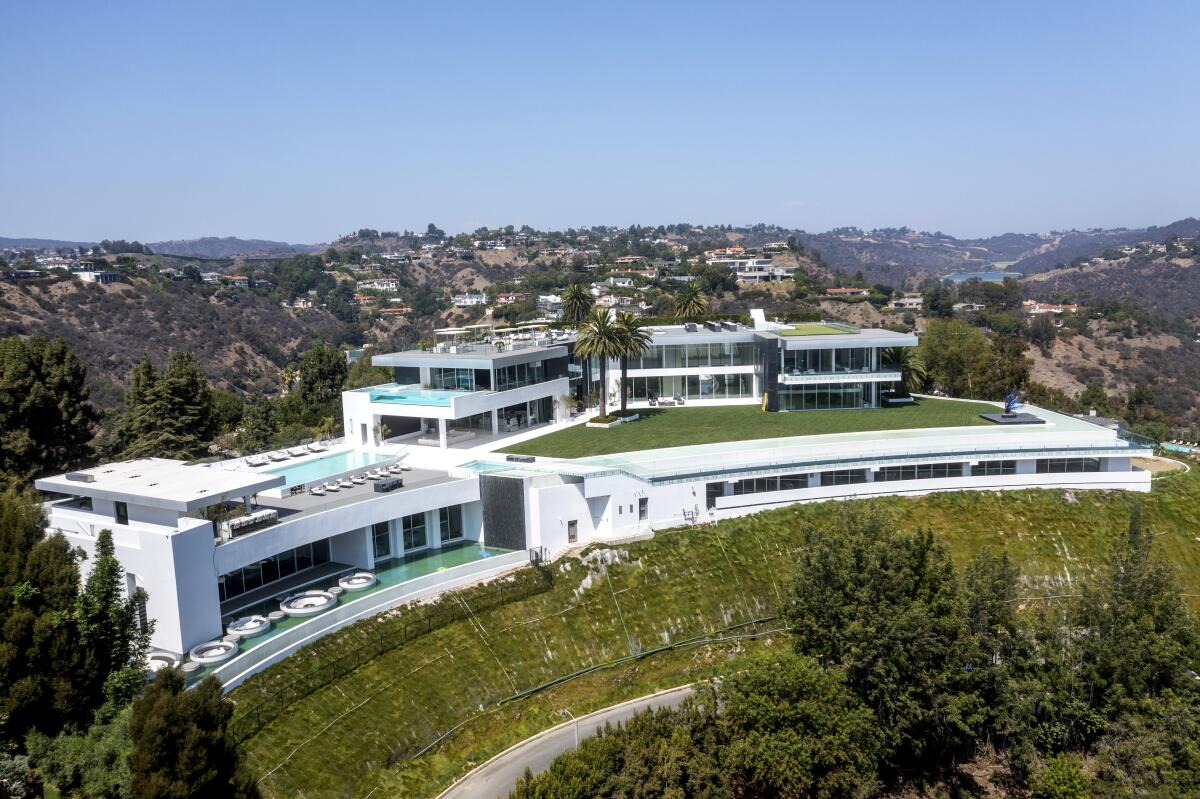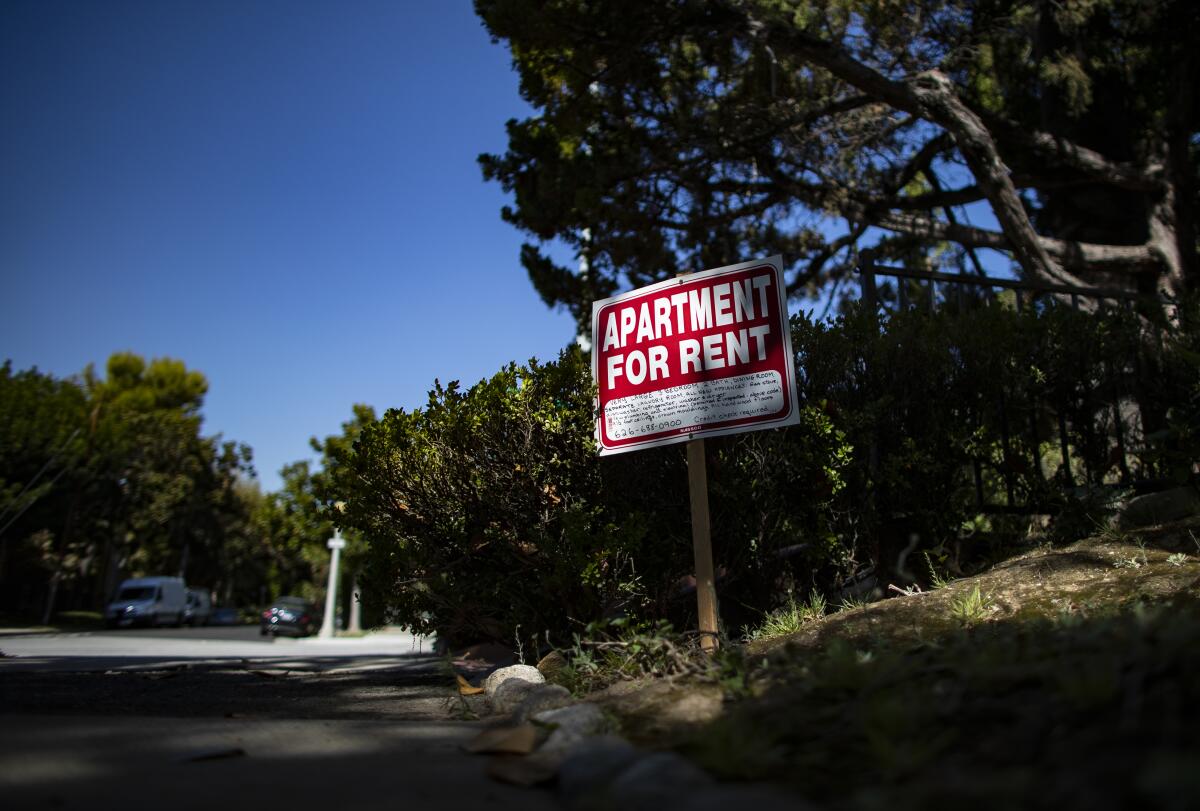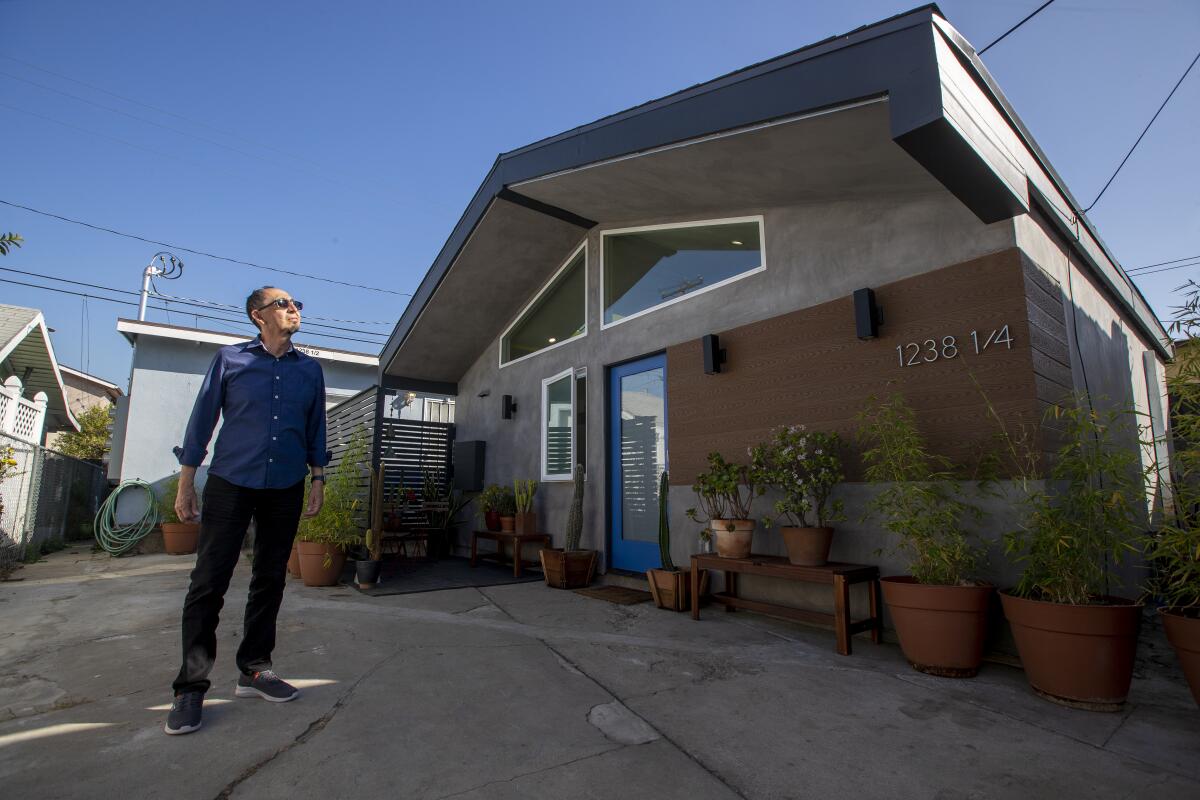Real Estate newsletter: Who dropped $141 million on The One?

- Share via
Welcome back to the Real Estate newsletter. All good things must come to an end, and this week saw what might be the final chapter in a long, drawn-out saga that brought some of the juiciest drama that the Southern California housing market has seen in years.
In a way, it’s almost sad. Watching the filthy rich wrestle over “The One,” the biggest modern home in America, has been a constant source of schadenfreude over the last decade. But that’s over now, because the mega-mega-mega-mansion has been auctioned off to the highest bidder, and The Times was the first to find the buyer: Fashion Nova owner Richard Saghian.
It makes sense that the glitzy, glamorous home would sell to Saghian, a fast-fashion mogul who grew the juggernaut brand through collaborations with influencers such as rapper Cardi B and model Kylie Jenner. Saghian spent $141 million on the mansion, which is by far the most ever paid for a home at auction.
And so we say goodbye to “The One” and its ever-flowing source of headlines, which saw L.A.’s most ambitious developer erect a 105,000-square-foot palace only to lose the prized property to his many lenders, who fought over its future and eventually decided to recoup their losses by selling it off for significantly less than they were owed. Along the way, we saw the developer hatch scheme after scheme. At one point, he pitched turning the residential property into a boxing venue. Later, he tried creating a cryptocurrency backed by the house itself.
Perhaps Saghian will try a zany scheme of his own with the home. Until then, we bid farewell to the infamous property.
Out in Hidden Hills, another prized compound surfaced for sale: Drake’s “Yolo Estate.” The hip-hop star dropped more than $70 million on a Beverly Crest home last month, and weeks later, he listed his party property complete with three homes, two pools and a mechanical bull for a combined $22.2 million.
Moving on to news you can use, as this week was filled with relevant legislation for L.A. renters and homeowners.
For starters, The Times looked into the implementation — or lack thereof — of Proposition 19, which was passed in 2020 and gives older California homeowners tax breaks when they move. Many eligible owners have been shocked by their pricey property tax bills, though, because the L.A. County assessor’s office still hasn’t completed any of the 1,271 applications it has received nearly a year after the law took effect.
For renters, L.A. City Council members are considering a package of renter-protection measures that would help promote fair access to housing by not allowing landlords to screen prospective tenants using criminal, eviction or credit histories.
Speaking of renting, we also ran down what you need to know about rent control if you’re building an ADU. Based on location and when your house and the ADU were built, the units may be subject to rent-control rules. Take a peek to see if yours would be affected.
While catching up on the latest, visit and like our Facebook page, where you can find real estate stories and updates throughout the week.
The One’s mystery buyer is revealed

Richard Saghian, owner of fast-fashion behemoth Fashion Nova, was the winning bidder who spent $141 million to buy “The One” mega-mansion.
Saghian, whose company has benefited from its association with celebrities and influencers such as pop superstar Lil Nas X, beat out four other bidders for the unfinished Bel-Air hilltop manse — the largest home in Los Angeles.
“The One,” which already has been rented out for filming, is the magnum opus of flamboyant developer Nile Niami. He initially marketed the home for $500 million several years ago but was forced to put it into bankruptcy after Crestlloyd, the home’s limited liability company, defaulted on $106 million in construction loans to L.A. billionaire Don Hankey.
Although some in the L.A. real estate community have dismissed the residence as garish, others have seen it as the ultimate trophy home — with a list of amenities aimed at the party set. There is a sky deck with cabanas, multiple pools, a private theater, a bowling alley, a billiard room, a candy room, and salon and spa as well as a nightclub. It has 21 bedrooms and 42 full bathrooms.
Drake buys a mansion, lists another

In February, Drake turned heads when he dropped more than $70 million on a trophy home in Beverly Crest. The blockbuster deal marked the end of a yearlong house hunt that saw the rapper make his first move into the Los Angeles area.
A week later, the Grammy-winning hip-hop star is going on a selling spree, shopping around three homes he owns in the quiet, star-studded community of Hidden Hills for a combined $22.2 million.
Drake has been compiling the compound for a decade, first buying an English Tudor-style mansion for $7.7 million in 2012. He purchased the ranch right next to it for $2.85 million in 2015, and three years later, he picked up another neighboring ranch for $4.5 million, creating a triple-lot estate that spans 6.5 acres.
The crown jewel of the compound is the “YOLO Estate” — slang for “you only live once” — that Drake transformed into a party house during his stay. Rustic on the outside with Tudor-style flourishes, the home opens to 12,500 square feet of dramatic spaces with seven bedrooms, nine bathrooms, six fireplaces, a wine cellar, tasting room, bar, recording studio and movie theater.
Older homeowners suffer as tax benefits stall

Rose Liebermann opened her property tax bill and did a double take, writes Ben Poston.
The $15,584 she owes on her new West Hills home is almost four times as much as the taxes on her previous house in Granada Hills, where she had lived for more than 30 years.
It wasn’t supposed to be that way. Proposition 19, narrowly approved by California voters in 2020, gives older homeowners a property tax break when they move. Specifically, it allows those 55 and older to blend the taxable value of their previous home with the value of a new, more expensive home they purchase, resulting in significant property tax savings.
But processing delays at the Los Angeles County assessor’s office have left property owners like Liebermann facing hefty tax bills that must be paid while they wait for their applications to be approved.
Nearly a year after the law took effect, the assessor’s office has not completed any of the 1,271 applications it has received to recalculate the property taxes for older and disabled homeowners under the law.
Possible renter protections on the way

Three Los Angeles City Council members introduced a package of renter-protection measures they say would help promote fair access to housing amid the city’s worsening homelessness crisis, writes Julia Wick.
The motions introduced Wednesday by Council Members Mike Bonin, Marqueece Harris-Dawson and Nithya Raman would significantly restrict what kind of information landlords can seek from prospective tenants.
The proposed ordinances would prohibit screening prospective tenants on the basis of their criminal, eviction or credit histories. Landlords would also be required to publicly display uniform rental criteria before renters pay application fees.
“It’s about making it easier for people to get housed and stay housed” amid the homelessness crisis and evictions that will come if pandemic-era tenant protections are repealed, Bonin said.
Could your ADU be rent-controlled?

Hoping to boost the supply of housing, California has made it far easier for homeowners to build accessory dwelling units, better known as granny flats or ADUs, writes Jon Healey. But an ADU could bring an unexpected wrinkle to your property along with the new tenants: rent control.
A new ADU probably wouldn’t be covered by rent control unless it was in the city of Los Angeles, where an emergency COVID-19 order has temporarily frozen rents on all properties. But a limit on rent increases could go into effect immediately on a single-family house on the same lot as a new ADU, even if it previously had been exempt.
In some cities, the house would also be subject to restrictions on evictions and other tenant protections.
What we’re reading
Although there might not be many homes on the market, there are still plenty of empty homes. The New York Times took a look at the 2020 census and found that nearly 10% of U.S. homes were “vacant” at the time. Due to the sheer number of homes in our populous state, California has one of the biggest vacancy totals in the country at 1,248,000 homes, but its vacancy rate is one of the lowest at 9%.
Modern home buyers have to compete with a growing number of investors and developers flooding the market. But a new tax bill would target those players in an attempt to make the market more fair for individual buyers. Called the California Speculation Act, the bill would impose a 25% tax on a home resold within three years after it’s bought, which specifically targets house flippers. The San Diego Union-Tribune has the details.
Inside the business of entertainment
The Wide Shot brings you news, analysis and insights on everything from streaming wars to production — and what it all means for the future.
You may occasionally receive promotional content from the Los Angeles Times.




